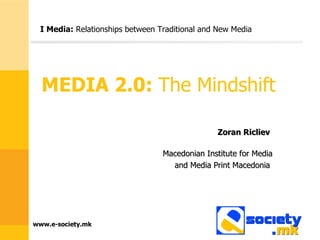Media 2.0: The Mindshift
- 1. MEDIA 2.0: The Mindshift Zoran Ricliev Macedonian Institute for Media and Media Print Macedonia I Media: Relationships between Traditional and New Media
- 2. Turbulent trends End of era of simple offer of prepackaged data Web 2.0 is about personalization and interconnecting
- 3. Turbulent trends The audience changed its habits. They need the content the way they want it, when they want it Participation
- 4. Turbulent trends The content is becoming live, real time editable The news article develops through constant updates Comments become part of the article
- 5. Turbulent trends A single tweet, from anywhere, even without an additional picture, video or audio clip, can make a big change in just several seconds
- 6. Turbulent trends Social Media and citizen journalism influence the big media companies Citizen journalism Localization of content Developing own blog platforms
- 7. Turbulent trends The open philosophy of internet, weakens ability of media houses to monetize their naturally expensive content, online
- 8. Web 2.0 pressure Web native news media naturally accept the constant change
- 9. Web 2.0 pressure TV as powerful visual media is not threatened in its basic existence On-line TV is fast developing, even on mobile platforms
- 10. Web 2.0 pressure Radio is in similar position like TV Content can be read Additional channels
- 11. Web 2.0 pressure Newspapers have to change They have to become more visual (using the big canvas) more analytical, digested, and opinion oriented
- 12. Web 2.0 pressure Video did not exactly kill the radio star, so web 2.0 probably wonât kill newspapers
- 13. Media merging Online news has proved that has many advantages over traditional media, except the biggest drawback, to monetize its content to sustainable level
- 14. Media merging Integrated multimedia newsrooms are developed as a place where all the news come first
- 15. Media merging Delivering the same initial content, through different channels, and in different form is most appreciated model. But there are some other barriers to do this
- 16. Media merging Hybrid models tend to be best at the time, with its ability to monetize the content through revenues from different platforms
- 17. Mainstream vs. Social Media Merging of social networks, blog society and mainstream media is ongoing
- 18. Mainstream vs. Social Media If MSM fail to adapt to the new conditions, their name loses its base, since social media are mainstream for certain communities, or age groups
- 19. Mainstream vs. Social Media Media is doing the news the âmindâ way, and the bloggers are doing it the âheartâ way
- 20. Mainstream vs. Social Media A good blogger or web activist, should adopt something from the professional journalists
- 21. Mainstream vs. Social Media Professional journalists should take their fancy suits off and get more into the masses
- 22. Mainstream vs. Social Media The antagonism between journalists and bloggers fades . They learn from each other
- 23. Journalism 2.0 Being web native, social platforms develop fast and gain quality MSM are rarely web native
- 24. Journalism 2.0 Mainstream media struggle with old habits
- 25. Journalism 2.0 Direct hit into journalistic identity
- 26. Journalism 2.0 The reporters for the 21 century Multitasking fast and clear writing flexible working hours no âfearâ of technology multimedia approach internet as a tool
- 27. Journalism 2.0 Many journalists are not prepared to accept the change Fear of citizen journalism
- 28. Macedonia case No real 24/7 journalism Journalists havenât overcome the âfearâ of computers Very few use or know what Twitter is
- 29. Macedonia case Media websites in Macedonia come from another age The web sites of classic media brands are edited by one person, which is usually not a journalist
- 30. Macedonia case Few online ads, No AdSense, No serious online advertising agency PayPal doesnât work Few have ever bought something through the web
- 31. Macedonia case Despite rudimentary media websites, visits are still rising
- 32. Macedonia case We still have university professors of journalism that think that internet will die within next three years
- 33. Macedonia case The crisis, as a platform for change, is always good for new ideas Social media, as web native, has a chanse to fill the gap MSM misses
- 34. MEDIA 2.0: The Mindshift Zoran Ricliev mail: [email_address] http://twitter.com/xorran http://www.linkedin.com/in/ricliev Thank you


































![MEDIA 2.0: The Mindshift Zoran Ricliev mail: [email_address] http://twitter.com/xorran http://www.linkedin.com/in/ricliev Thank you](https://image.slidesharecdn.com/media20themindshift-091202152741-phpapp01/85/Media-2-0-The-Mindshift-34-320.jpg)